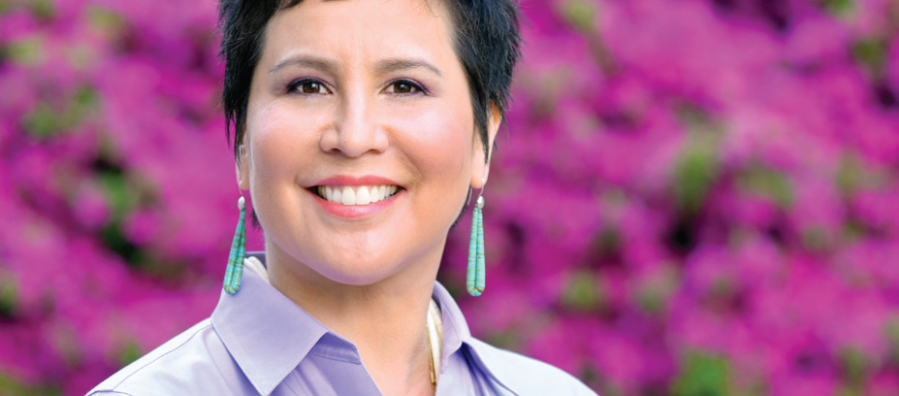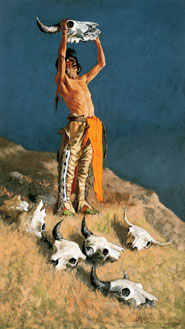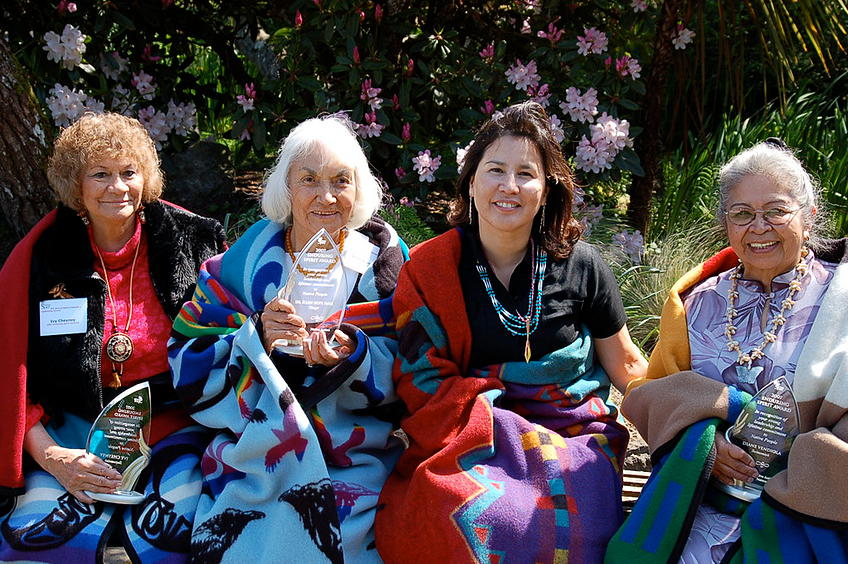
Debora Juarez
Debora Juarez was born and raised in Tacoma and currently lives in Seattle. She is an enrolled member of the Blackfeet Nation. As an attorney, she concentrates her practice on providing legal and financial counsel to tribes, regionally and nationally. She served as a King County Superior Court Judge, as the Executive Director of the Washington Governor’s Office of Indian Affairs, and is Chair of the Williams Kastners Tribal Practice Group. Debora is now the Seattle City Councilmember for District 5, and the first Native American woman to serve on the council. For more on Debora please see www.deborajuarez.org.
What are your thoughts on artworks depicting Blackfeet individuals, like Remington’s Conjuring Back the Buffalo?
 If this was painted around the late 1800s, it would have been right after the treaty times, when the tribe was restricted to a reservation, and still during the war times. Remington had seen the Blackfeet when he traveled to Montana, but he also knew his audience on the East Coast and was painting to sell. You weren’t going to find Blackfeet people buying this, it is Christianized and anglicized to fit the sensibilities of the era and the market.
If this was painted around the late 1800s, it would have been right after the treaty times, when the tribe was restricted to a reservation, and still during the war times. Remington had seen the Blackfeet when he traveled to Montana, but he also knew his audience on the East Coast and was painting to sell. You weren’t going to find Blackfeet people buying this, it is Christianized and anglicized to fit the sensibilities of the era and the market.
There are some things I know immediately are not accurate. For example, we don’t worship towards the sky like this, that is a Christian orientation. We worship in medicine lodges and through ceremony. Also, the people leading spiritual ceremonies weren’t men, they were women. While men were in charge of external power, women had interior, spiritual, and domestic power. They were the centers of the community. We also never wore long braids like this because someone could grab hold of them in battle. We never wore the classic war bonnet you see everywhere either, our headdresses rose straight up.
It is a beautiful piece but it is not realistic. It is almost a fairytale, but that doesn’t take away from the beauty. I’m not offended by it, I’m immune, I’m used to it as a Native person.
What are your thoughts on the portrayal of Native peoples as elements of the past in western American art?
My mother always used to say, “Why would we go kill a deer when there is a Safeway down the street.” We’re not stupid and we’re not set in stone. But to think that Native people can’t change makes non-Natives feel comfortable. It is safe if we are contained, regulated. We are still the most regulated ethnic group in the country, right down to blood quantum. What race of people would you confine to the 17th century in every way—politically, socially, and culturally? Some people want to encapsulate Native Americans in amber and keep them there.
We’re not locked in the past. We move along with the times. Just as you have evolved, so have we.
What do you want people to know about Native American cultures?
Native American culture is like language: it is fluid, it changes, it is nuanced. One of the best things I learned from Darrell Kipp, who ran the Blackfeet immersion program, was, “Language is culture and culture is behavior. If you change the language you change the behavior.”
I’ll give you an example of how language and culture are linked. A certain moon marks the change to a specific season around the spring. In the past, wolves would howl at the moon that time of year. After a certain period in settlement, when most of the wild animals were gone or had been killed, there were no wolves left to howl to signal the arrival of the season to the Blackfeet people, and so we lost the word for that type of moon for more than 80 years.
What can our museum do to support Native peoples?
Allow each tribe to contribute their own narratives. Point out the inaccuracies in depictions of Native people and give these works historical context. Educate the people seeing them. That would make the experience much more enriched and would go a long way towards alleviating stereotypes. Also, show the evolution, show contemporary Native art.
There is a long and complicated history between Native Americans and museums, and no one has been able to completely bridge tribes and museums together. There are often opposite interests. But it is good that museums today are trying to work more closely with Native American communities.
Do you have any further comments?
I have some insight to share about the phrase, “I’m at the bottom of the totem pole.” One of the things I learned from Uncle Billy [Billy Frank Jr.] is that the bottom of the totem pole for many Coastal people is actually a place of honor. Often women are depicted in that position holding up the rest of the pole because they are a source of strength and hold up their communities. It is another example of how western sensibilities have led to a misunderstanding of Native culture. The orientation towards the sky is Christian and western, but for Native people the place at the bottom of the totem pole touching the earth is the position of most spiritual significance.

Image credits (top to bottom): Image of Debora Juarez provided by Debora Juarez. Frederic Remington (American, 1861‑1909), Conjuring Back the Buffalo, circa 1889. Oil on canvas, 35 í— 20 inches. Tacoma Art Museum, Haub Family Collection, Gift of Erivan and Helga Haub, 2014.6.100. Image of Debora Juarez with Enduring Spirit Award Honorees, 2007, courtesy of Native Action Network.